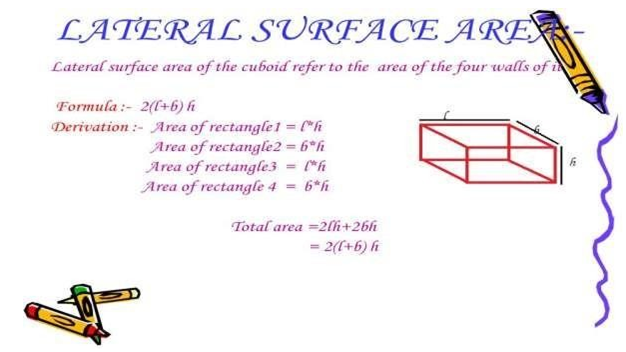CLASS-7
LATERAL SURFACE AREA OF CUBOID
LATERAL SURFACE AREA OF CUBOID (LSA) -
The lateral surface area of a cuboid refers to the area of the four vertical faces (excluding the top and bottom faces). If the cuboid has a length (l), width (w), and height (h), then the lateral surface area can be calculated as follows:
Formula for Lateral Surface Area of a Cuboid-
Lateral Surface Area = 2h (l + w)
Where:-
- l = length
- w = width
- h = height
This formula is derived by adding the areas of the four vertical rectangular faces, each with dimensions of height and either length or width.

Lateral surface area of a Cuboid:-
It is actually the area of the 4 faces of a cuboid except the top and the bottom. The sum of surface areas of all sides except the top and bottom face of solid is defined as the lateral surface area of a solid. Consider a Cuboid of length, breadth and height to be l, b and h respectively.
Lateral surface area of the cuboid = Area of face ADHE + Area of face BCGF + Area of face ABFE + Area of face DCGH = 2(b × h) + 2(l × h) = 2h (l + b)
LSA of Cuboid = 2h (l +b)
How to find out area of the 4 walls/ lateral surface area of a rectangular room?
Since the 4 walls of a rectangular room are also rectangles, we find their area separately by using the formula l x b.
· Area of the rectangles whose sides are l and h will be l x h each.
· Area of the remaining rectangles whose sides are b and h will be b x h each.
· So, total area of 4 walls = (l x h) + (l x h) + (b x h) + (b x h)
= 2 (l x h) +2 (b x h)
Area of 4 walls = 2 h (l + b) (Taking 2h common),
Example.1) If the length, breadth and height of a cuboid are 5 cm, 3 cm and 4 cm. The find its lateral surface area.
Ans.)
Given, Length = 5 cm,
Breadth = 3 cm,
and Height = 4 cm,
So, LSA = 2h (l + b)
LSA = 2 x 4 (5 + 3)
LSA = 2 x 4 (8)
LSA = 2 x 32 = 64 cm² (Ans.)